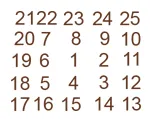我希望能够创建一个函数,输入一个数字,函数将返回从1到该数字的螺旋形状(以二维数组形式)。例如,如果我将数字25传递给函数,它将返回以下结果:

我尝试了不同的方法,但都没有成功。我无法理解。
希望我已经清楚地表达了自己的意思。

我尝试了不同的方法,但都没有成功。我无法理解。
希望我已经清楚地表达了自己的意思。

这里主要的问题是对坐标进行枚举 - 将数字与坐标匹配,然后以任何您想要的方式打印出来。
首先注意两个基本模式:
因此,按照这些规则编写一个生成器,产生 数字,坐标 元组。
如果您首先设置一些辅助函数,那么它会更清晰; 我会尽可能详细:
def move_right(x,y):
return x+1, y
def move_down(x,y):
return x,y-1
def move_left(x,y):
return x-1,y
def move_up(x,y):
return x,y+1
moves = [move_right, move_down, move_left, move_up]
很容易,现在是生成器:
def gen_points(end):
from itertools import cycle
_moves = cycle(moves)
n = 1
pos = 0,0
times_to_move = 1
yield n,pos
while True:
for _ in range(2):
move = next(_moves)
for _ in range(times_to_move):
if n >= end:
return
pos = move(*pos)
n+=1
yield n,pos
times_to_move+=1
演示:
list(gen_points(25))
Out[59]:
[(1, (0, 0)),
(2, (1, 0)),
(3, (1, -1)),
(4, (0, -1)),
(5, (-1, -1)),
(6, (-1, 0)),
(7, (-1, 1)),
(8, (0, 1)),
(9, (1, 1)),
(10, (2, 1)),
(11, (2, 0)),
(12, (2, -1)),
(13, (2, -2)),
(14, (1, -2)),
(15, (0, -2)),
(16, (-1, -2)),
(17, (-2, -2)),
(18, (-2, -1)),
(19, (-2, 0)),
(20, (-2, 1)),
(21, (-2, 2)),
(22, (-1, 2)),
(23, (0, 2)),
(24, (1, 2)),
(25, (2, 2))]
这里有一张图可以帮助你理解问题:

你可以把它想象成重复向一个 N×N 的正方形添加内容,以制作一个 (N+1)×(N+1) 的正方形:
if N is odd:
move right one step
move down N steps
move left N steps
else:
move left one step
move up N steps
move right N steps
每一步您都要将一个数字写到当前位置。
正如@Milan所指出的那样,您可能并不总是想要完成当前的shell(例如,如果您只想数到23)。最简单的方法是创建一个生成器函数来产生无限的步骤,然后只消耗您需要的步骤:
from itertools import count
def steps_from_center():
for n in count(start=1):
if n % 2:
yield RIGHT
for i in range(n):
yield DOWN
for i in range(n):
yield LEFT
else:
yield LEFT
for i in range(n):
yield UP
for i in range(n):
yield RIGHT
UP,DOWN,LEFT和RIGHT。my_array[y][x]进行访问,其中x从左到右递增,y从上到下递增(这与我们期望打印输出的顺序相匹配)。from collections import namedtuple
Step = namedtuple("Step", ["dx", "dy"])
RIGHT = Step( 1, 0)
DOWN = Step( 0, 1)
LEFT = Step(-1, 0)
UP = Step( 0, -1)
在分配存储空间之前,我们需要知道所需数组的大小:
from math import ceil, floor, log10, sqrt
max_i = int(input("What number do you want to display up to? "))
# how big does the square have to be?
max_n = int(ceil(sqrt(max_i)))
# here is our initialized data structure
square = [[EMPTY] * max_n for _ in range(max_n)]
# and we start by placing a 1 in the center:
x = y = max_n // 2
square[y][x] = output(1)
我在这里添加了两个额外的部分:为了使输出整洁,每个项都应该打印相同的宽度。 output() 是一个函数,它接受一个值并返回正确宽度的字符串,而 EMPTY 是该宽度的一串空格:
# how many digits in the largest number?
max_i_width = int(floor(log10(max_i))) + 1
# custom output formatter - make every item the same width
def output(item, format_string="{{:>{}}}".format(max_i_width)):
return format_string.format(item)
EMPTY = output("")
for i, step in enumerate(steps_from_center(), start=2):
if i > max_i:
break
else:
x += step.dx
y += step.dy
square[y][x] = output(i)
print("\n".join(" ".join(row) for row in square))
What number do you want to display up to? 79
73 74 75 76 77 78 79
72 43 44 45 46 47 48 49 50
71 42 21 22 23 24 25 26 51
70 41 20 7 8 9 10 27 52
69 40 19 6 1 2 11 28 53
68 39 18 5 4 3 12 29 54
67 38 17 16 15 14 13 30 55
66 37 36 35 34 33 32 31 56
65 64 63 62 61 60 59 58 57
from functools import partial
from math import ceil, sqrt
def gen_grid(n):
grid_size = int(ceil(sqrt(n)))
return [[None for _ in range(grid_size)] for _ in range(grid_size)]
def valid_coord(grid, coord):
try:
return grid[coord[0]][coord[1]] is None
except:
return False
def origin(size):
adjustment = 1 if size % 2 == 0 else 0
return (size / 2 - adjustment), (size / 2 - adjustment)
north = lambda y, x: (y - 1, x)
south = lambda y, x: (y + 1, x)
east = lambda y, x: (y, x + 1)
west = lambda y, x: (y, x - 1)
directions = lambda y, x: [east(y, x), south(y, x), west(y, x), north(y, x)]
distance = lambda c, nxt: sqrt((c[0] - nxt[0]) ** 2 + (c[1] - nxt[1]) ** 2)
def walk_grid(nums):
grid = gen_grid(len(nums))
center = origin(len(grid[0]))
current_position = center
center_distance = partial(distance, center)
for n in nums:
y, x = current_position
grid[y][x] = n
unseen_points = [c for c in directions(y, x) if valid_coord(grid, c)]
if n != nums[-1]:
current_position = sorted(unseen_points, key=center_distance)[0]
return grid
def print_grid(highest):
result = walk_grid(range(1, highest + 1))
for row in result:
for col in row:
print "{:>4}".format(col if col is not None else ''),
print "\n"
示例输出:
In [2]: grid.print_grid(25)
21 22 23 24 25
20 7 8 9 10
19 6 1 2 11
18 5 4 3 12
17 16 15 14 13
direction = Vec2(-direction.y, direction.x),其中方向初始化为Vec2(1, 0)。这些都很有趣!(我的螺旋代码从左上角开始,一直工作到中心,只需反转生成的列表即可从内向外走!) - SapphireSun所以我假设你已经可以在某种程度上确定数组的大小和“1”的位置。现在你需要一个允许你改变方向和计数器的函数。
def get_new_direction(direction):
switch direction:
case E: return S
case S: return W
case W: return N
case N: return E
i,j = initial_coordinates_of_the_one
direction = right
steps = 1
next_number = 1
while not done:
place(next_number, i, j)
i,j = get_coordinates_after_move(direction, steps)
direction = get_new_direction(direction)
next_number++
if iteration is even:
steps++
这只是一个草图。还有一些缺失的部分(但很容易想到):
switch 语句或运算符 ++。 - Davidmh